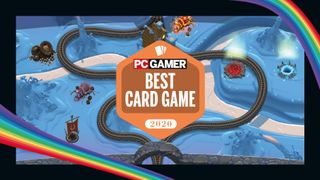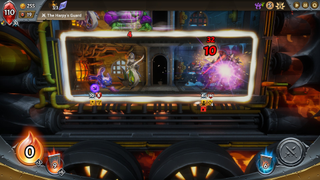Best Card Game 2020: Monster Train
Next stop: a chaotic deckbuilder that's rolling into Slay the Spire's station.

Monster Train is the Best Card Game of 2020! Want more awards? We'll be updating our GOTY 2020 hub with new awards and personal picks throughout December.
Wes Fenlon: It's impossible to play Monster Train without Ozzy Osbourne singing Crazy Train in your head. And honestly, that's exactly how it should be, because it is a crazy train. My favorite thing about this deckbuilder is its wild makeup of factions, which I can mash together into unlikely allies. The Awoken, for example, are burly plant boys that I use as frontline defenders to soak up damage for units I place behind them. But depending on the faction I pair them with, that strategy totally changes.
With the Stygian Guard I sometimes like to go all-in on Spell Weakness, using puny magicians to stack a multiplicative debuff on enemies and then one-shotting them. But the Stygians also have a whole other set of warriors that grow stronger every time you play a spell, turning them into deadly direct damage dealers with the right hand of cheap cards.
It's breezier than Slay the Spire. You might even, in a very un-roguelike fashion, win your very first run. But it keeps layering on new challenges, and after a few hours it becomes clear that the easier start was just Monster Train's way of making sure it's firmly set its hook before reeling you in. Getting the train to the end of the tracks isn't your end goal—the real reward is building a killer faction combination that feels unbeatable, then finding a single card or relic to build an even better combo around. That's when things really go off the rails. Ay ay ay.
Robin Valentine: I’ve described Monster Train in the past as a game for people who’ve already put 200 hours into Slay the Spire, though that’s maybe a little uncharitable. It definitely walks in that game’s shadow—and overall, Slay the Spire is the more focused and finely-tuned experience. But Monster Train’s relative messiness is its strength.
It combines the core tactical deck-building of its inspiration with a kind of exuberant chaos that never stops escalating through a run. Your roster is always stacked with ridiculous powers and abilities, and with overwhelming odds stacked against you, you’re actively encouraged to throw together effects in combinations that would feel utterly broken in any other game.
Slay the Spire’s cold efficiency is a wonderful challenge that keeps me coming back again and again—but Monster Train is gleeful explosion of illegal fireworks that never lets the adrenaline drop long enough to let you get bored. As someone who has put 200 hours into Slay the Spire, it’s a brilliant change of pace.
The biggest gaming news, reviews and hardware deals
Keep up to date with the most important stories and the best deals, as picked by the PC Gamer team.

Evan Lahti: Illegal fireworks! That's exactly it, Robin. Slay the Spire is zen and patience; Monster Train is a toybox, the feeling of lining up your favorite action figures and mashing them together against the bad guys. Bad guys who are, in this case, actual angels from heaven. But trust me, they're bad. You'll hate these guys.
Monster Train plays much more like a board game than most so-called digital card games, I think, and one of its biggest appeals is the clever structure of its board, the train. There are three chambers (a fourth, if you count the fragile heart of the train at the top), and each monster you play into one of these lanes eats up room capacity, a valuable commodity that can be grown or shrunk, and that impacts which monsters you'll be able to pair together. Enemies enter at the bottom, then flow upward, passing through each layer. So you're essentially building an angel filtration system.
This board format forces you to think carefully (but not agonizingly so) about the chronological flow of enemies, where you want to plug a thorny Animus who hurls damage at the back line, or toss down a certain status effect-inducing defender to debuff enemies. And like Wes mentioned, the blended, two-color decks remind me of the synergies of Magic: The Gathering. You have to think about how certain colors support one another, which nicely dovetails with the theme of hell's demons teaming up to break out of exile.

Wes has been covering games and hardware for more than 10 years, first at tech sites like The Wirecutter and Tested before joining the PC Gamer team in 2014. Wes plays a little bit of everything, but he'll always jump at the chance to cover emulation and Japanese games.
When he's not obsessively optimizing and re-optimizing a tangle of conveyor belts in Satisfactory (it's really becoming a problem), he's probably playing a 20-year-old Final Fantasy or some opaque ASCII roguelike. With a focus on writing and editing features, he seeks out personal stories and in-depth histories from the corners of PC gaming and its niche communities. 50% pizza by volume (deep dish, to be specific).
Most Popular

